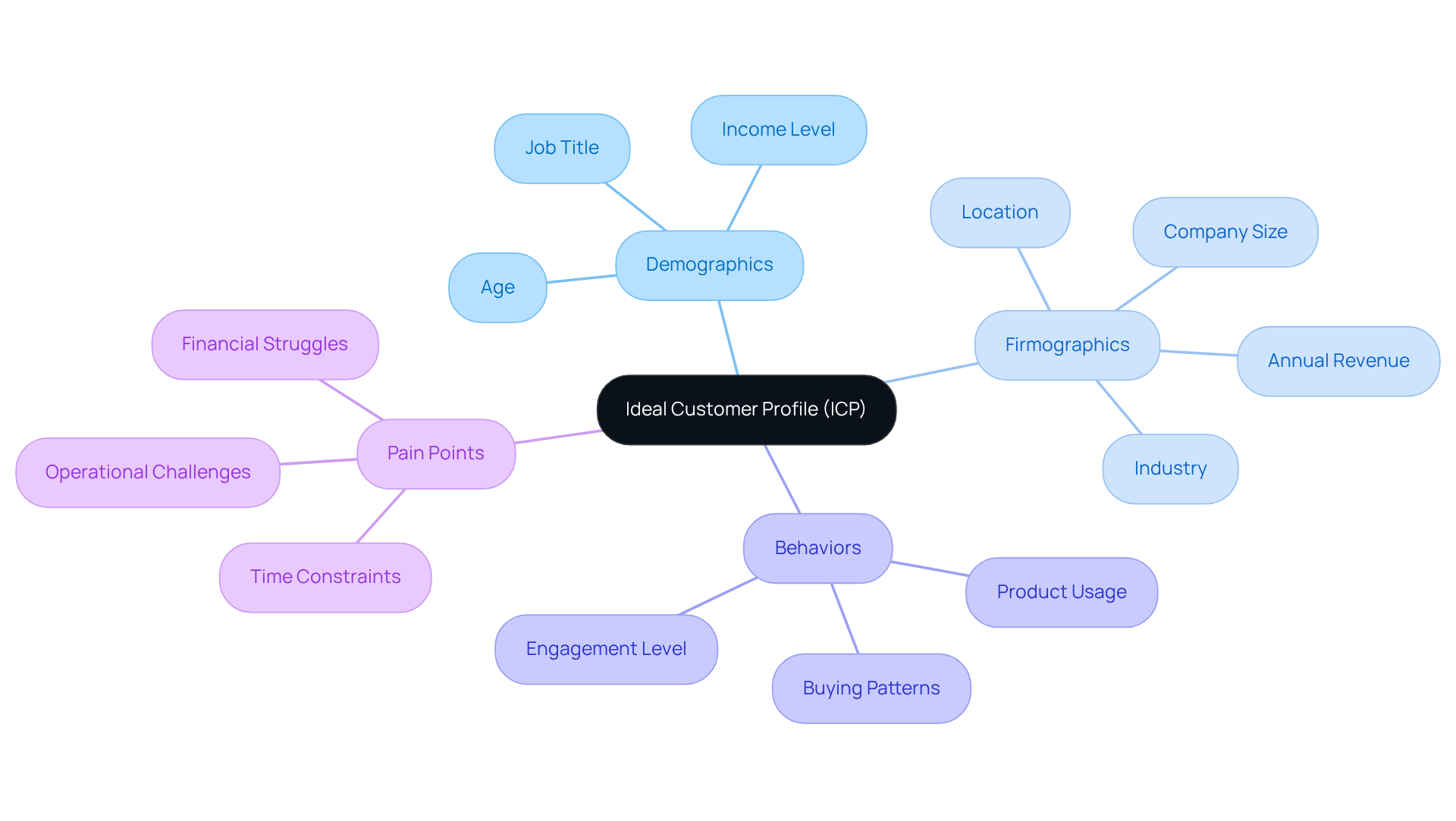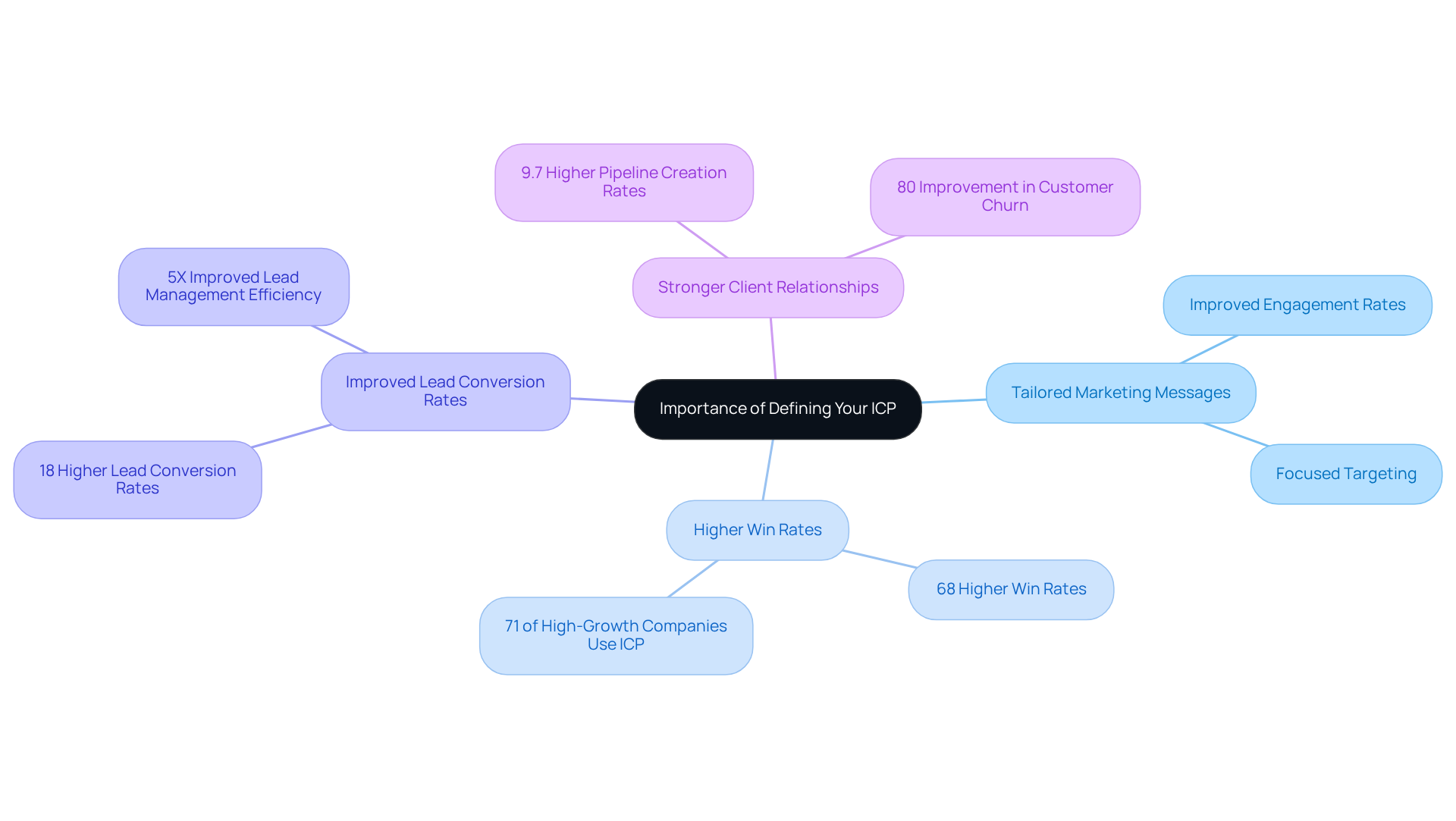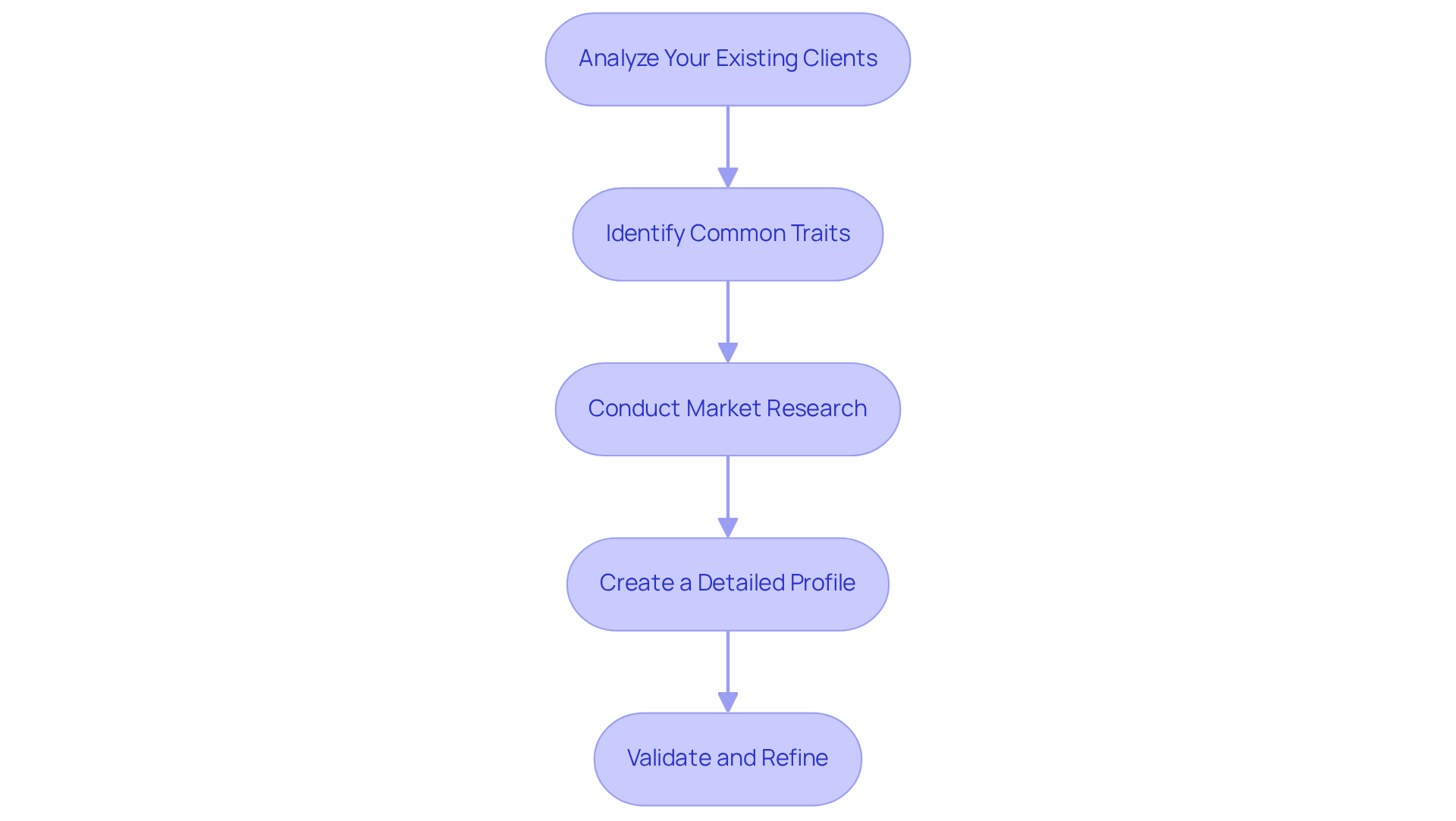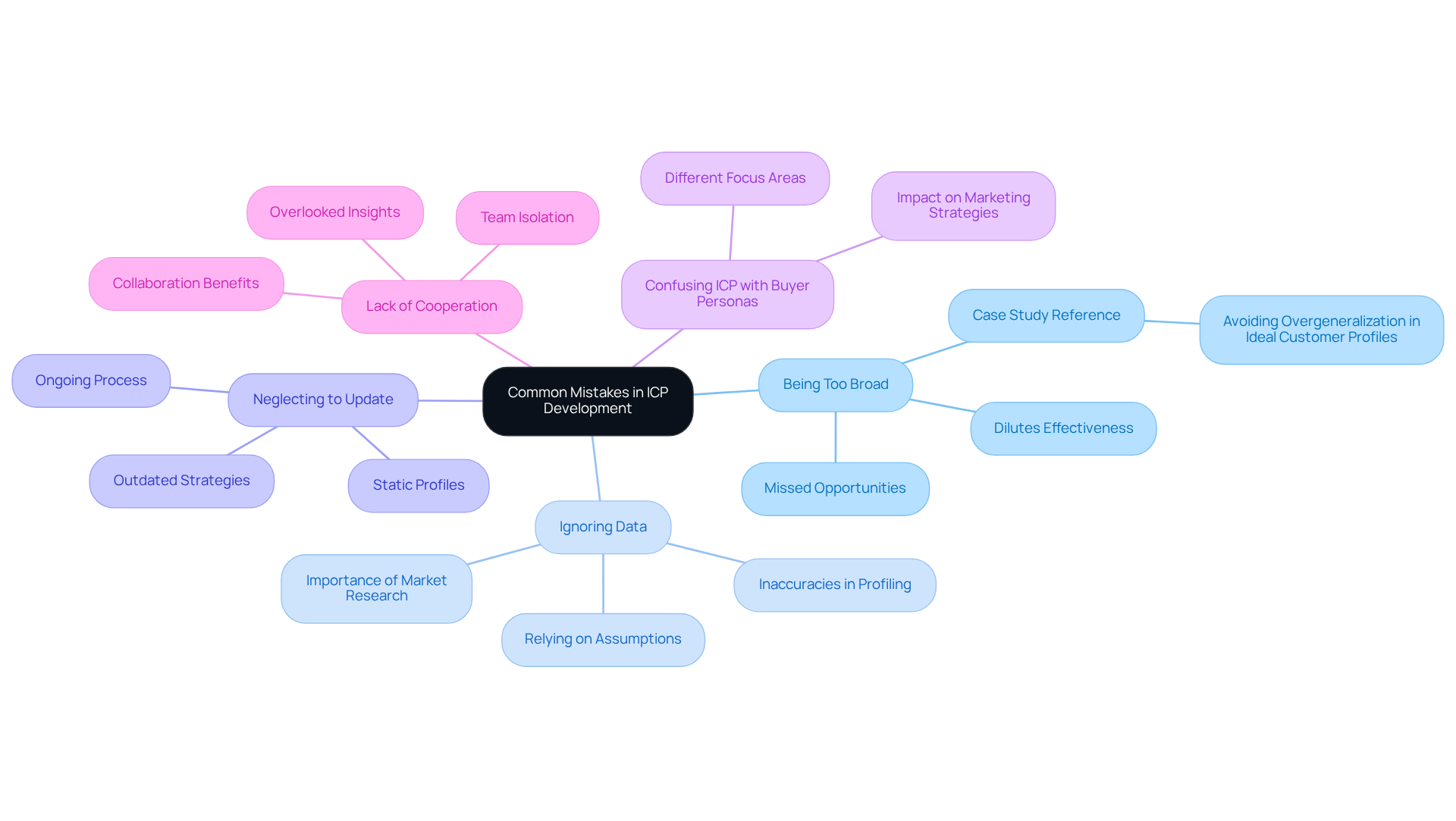Overview
Creating an Ideal Customer Profile (ICP) is a vital step for small business owners looking to enhance their marketing efforts and boost revenue efficiency. By understanding your existing clients and identifying their common traits, you can tailor your approach to meet their needs more effectively.
Have you ever wondered how your current customers found you? Conducting thorough market research can reveal valuable insights that guide your marketing strategy.
It's important to remember that your ICP is not a static document; it requires regular updates to remain relevant. Statistics show that businesses with a well-defined ICP achieve significantly higher win rates and lead conversion rates. This means that by nurturing your understanding of your ideal customers, you can create stronger connections and drive growth.
Together, we can achieve success by focusing on what truly matters—your customers. By investing time in developing and refining your ICP, you not only enhance your marketing efforts but also foster a deeper relationship with your audience.
Let's take this journey together and unlock the potential of your business.
Introduction
Defining an Ideal Customer Profile (ICP) is more than just a marketing trend; it’s a strategic necessity for businesses striving to flourish in today’s competitive landscape. By identifying the traits of customers who stand to gain the most from a product or service, organizations can fine-tune their marketing efforts and improve revenue efficiency. Yet, many businesses find themselves wrestling with the complexities of crafting an effective ICP.
What common pitfalls might you encounter on this journey, and how can we navigate these challenges together to ensure that your customer profiling leads to meaningful growth and success?
Understand the Ideal Customer Profile (ICP)
An Ideal Client Profile (ICP) serves as a comprehensive blueprint of the individual most likely to benefit from your product or service. This profile includes critical attributes such as demographics, firmographics, behaviors, and pain points. To effectively direct your marketing and revenue efforts toward customers who are most likely to convert, it is essential to define ICP clearly. This approach not only optimizes resource allocation but also enhances revenue efficiency.
Consider this: if your organization offers a software solution designed for small enterprises, your ICP might specify characteristics such as company size, industry, and the unique challenges these entities encounter that your product addresses. We understand that to define ICP can seem daunting, but it’s a crucial step toward connecting with those who truly need your help.
Studies show that companies employing clearly defined ICPs see a 32% rise in marketing-qualified leads and a 28% enhancement in productivity. Imagine the positive impact on your business! Moreover, aligning your revenue strategy with an ICP can result in a 68% higher account win rate. This highlights the significance of this approach in fostering growth and success for small businesses. Together, we can achieve remarkable outcomes by focusing on the clients who will benefit the most from your offerings.

Recognize the Importance of Defining Your ICP
It is crucial to define ICP, which stands for Ideal Customer Profile, for several reasons. It allows you to tailor your marketing messages, ensuring they resonate with your target audience, which can significantly boost engagement rates. By prioritizing leads that closely align with your ICP, your sales team can focus on prospects who are more likely to convert. This not only enhances the efficiency of the sales process but also fosters a sense of purpose in your efforts.
Research shows that firms utilizing a well-defined ICP achieve win rates that are 68% higher than those lacking one, along with improved client retention. Have you considered how defining ICP could transform your business? Additionally, B2B organizations that regularly A/B test their ICPs experience lead conversion rates up to 18% higher than those who don't. This insight could be a game changer for your strategy.
Companies that refresh their ICP quarterly enjoy a 9.7% higher pipeline creation rate compared to those that update less frequently. This targeted approach not only saves time but also nurtures stronger relationships with clients who genuinely need your solutions. Together, we can drive growth and success by understanding and addressing your unique challenges.

Follow Steps to Create Your Ideal Customer Profile
A vital step in your journey as a small business owner is to define ICP by creating your Ideal Customer Profile. Let's explore some essential steps together:
-
Analyze Your Existing Clients: Start by examining your current clientele. Who are your top customers—those who contribute the most revenue and show high retention rates? This analysis is crucial, especially considering that 65% of small enterprises rely on personal funds. Understanding who drives your income can have significant financial implications.
-
Identify Common Traits: Look for trends among your top clients. What industries do they belong to? What are their company sizes, and what specific challenges do they face that your product or service can address? For instance, organizations in healthcare and social assistance often display resilience due to the steady demand for their services.
-
Conduct Market Research: Engage in surveys, interviews, and market analysis to gather data on potential clients. This research will provide insights into their needs and preferences. Remember, 42% of businesses fail due to insufficient market demand, which highlights the importance of thorough market research to define ICP.
-
Create a Detailed Profile: Compile the information you've gathered into a comprehensive profile that includes demographic data, firmographics, pain points, and buying behaviors. This profile should embody the traits of your ideal client, enabling you to tailor your marketing efforts effectively.
-
Validate and Refine: Test your ICP by integrating it into your marketing and sales strategies. Gather feedback from your team and clients, making adjustments as needed to ensure it accurately reflects your ideal audience. Continuous improvement is key; after all, 82% of startups cite cash flow issues as a major cause of failure. As highlighted by the U.S. Small Business Administration, effective cash flow management is essential for sustaining your business operations. Together, we can navigate these challenges and build a successful client strategy.

Avoid Common Mistakes in ICP Development
When developing your Ideal Customer Profile (ICP), it's crucial to avoid these common pitfalls that many small business owners face:
-
Being Too Broad: Creating an ICP that lacks specificity can dilute its effectiveness. To define ICP, a well-defined ICP should focus on distinct characteristics that accurately represent your ideal client, such as industry, company size, and specific challenges your product can address. Broad profiles often lead to missed opportunities and wasted resources, as they do not capture the unique characteristics of your best clients. For instance, many businesses create profiles that are too broad, resulting in missed opportunities, as highlighted in the case study "Avoiding Overgeneralization in Ideal Customer Profiles."
-
Ignoring Data: Relying on assumptions or anecdotal evidence can result in inaccuracies. To create a robust ICP, leverage data from your current clientele and conduct thorough market research. Interacting with clients through surveys or focus groups can offer valuable insights that improve the precision of your profile. Remember, effective customer profiling can lead to sharper marketing messaging and enhanced revenue results.
-
Neglecting to Update: An ICP is not static; it should evolve alongside your business and market conditions. Regularly revisiting and refining your ICP ensures it remains relevant and effective in guiding your sales and marketing strategies. Neglecting to refresh your ICP can lead to outdated methods that do not connect with present client needs. As your business grows, refining your ICP is an ongoing process that can adapt to changing market dynamics.
-
Confusing ICP with Buyer Personas: While both are essential for effective marketing, it's important to distinguish between them. An ICP focuses on the ideal company or customer type, while buyer personas delve into the behaviors and motivations of individual decision-makers. Misunderstanding this distinction can lead to confusion in your marketing strategies, ultimately hindering your outreach efforts. Clarifying this distinction can enhance your marketing strategies and ensure targeted communication.
-
Lack of Cooperation: Creating an ICP should entail teamwork among various departments, not just marketing and commerce. Isolated teams may overlook valuable insights that could improve marketing and business strategies. By fostering collaboration, you can create a more comprehensive ICP that aligns with your overall business objectives.
By steering clear of these traps, you can define ICP to develop a more efficient strategy that improves your revenue performance and fosters significant connections with your target audience. In conclusion, to define ICP, it is vital to have a clear Ideal Customer Profile for B2B sales success, as it focuses your efforts on high-quality leads, which can increase your chances of making sales. With Wayy.ai, users can establish over 60 target client connections each month, demonstrating the potential outcomes of effective profiling.

Conclusion
Defining an Ideal Customer Profile (ICP) is a pivotal strategy for businesses eager to enhance their marketing and sales efforts. By identifying and understanding the characteristics of the customers most likely to benefit from your offerings, you can streamline resources and focus on high-quality leads that truly drive growth. A well-crafted ICP not only serves as a guide for targeting but also lays the foundation for building meaningful customer relationships.
In this article, we’ve outlined essential steps for creating an effective ICP. These include:
- Analyzing existing clients
- Identifying common traits
- Conducting market research
- Continuously refining the profile
Each step is crucial to ensuring that your ICP remains relevant and reflective of changing market dynamics. Moreover, by avoiding common pitfalls—such as being too broad or neglecting updates—you can significantly enhance the accuracy and effectiveness of your profiling process.
Ultimately, the significance of defining an ICP cannot be overstated. It empowers you to connect with your ideal customers, leading to improved engagement, higher conversion rates, and ultimately, greater success. Embracing this approach not only optimizes your marketing strategies but also fosters a deeper understanding of client needs, driving sustainable growth in a competitive landscape.
We encourage you to take the initiative to define your ICP today. Together, we can unlock the potential for remarkable outcomes in your business endeavors.
Frequently Asked Questions
What is an Ideal Customer Profile (ICP)?
An Ideal Customer Profile (ICP) is a detailed blueprint of the individual or organization most likely to benefit from your product or service. It includes key attributes such as demographics, firmographics, behaviors, and pain points.
Why is it important to define an ICP?
Defining an ICP is crucial because it helps direct marketing and revenue efforts toward customers who are most likely to convert. This approach optimizes resource allocation and enhances revenue efficiency.
How can an ICP impact marketing and productivity?
Companies with clearly defined ICPs have been shown to see a 32% increase in marketing-qualified leads and a 28% boost in productivity.
What specific characteristics might an ICP include for a software solution aimed at small enterprises?
An ICP for a software solution designed for small enterprises might specify characteristics such as company size, industry, and the unique challenges these companies face that the product addresses.
What is the potential impact of aligning a revenue strategy with an ICP?
Aligning a revenue strategy with an ICP can lead to a 68% higher account win rate, highlighting its importance in fostering growth and success for small businesses.




